Farm to School – The What, The Why, The History
What is Farm to School?
The National Farm to School Network (NFSN) has put forth the definition that Farm to School enriches the connection communities have with fresh, healthy food and local food producers by changing food purchasing and education practices at schools and early care and education sites. Farm to School includes one or more of the following core elements:
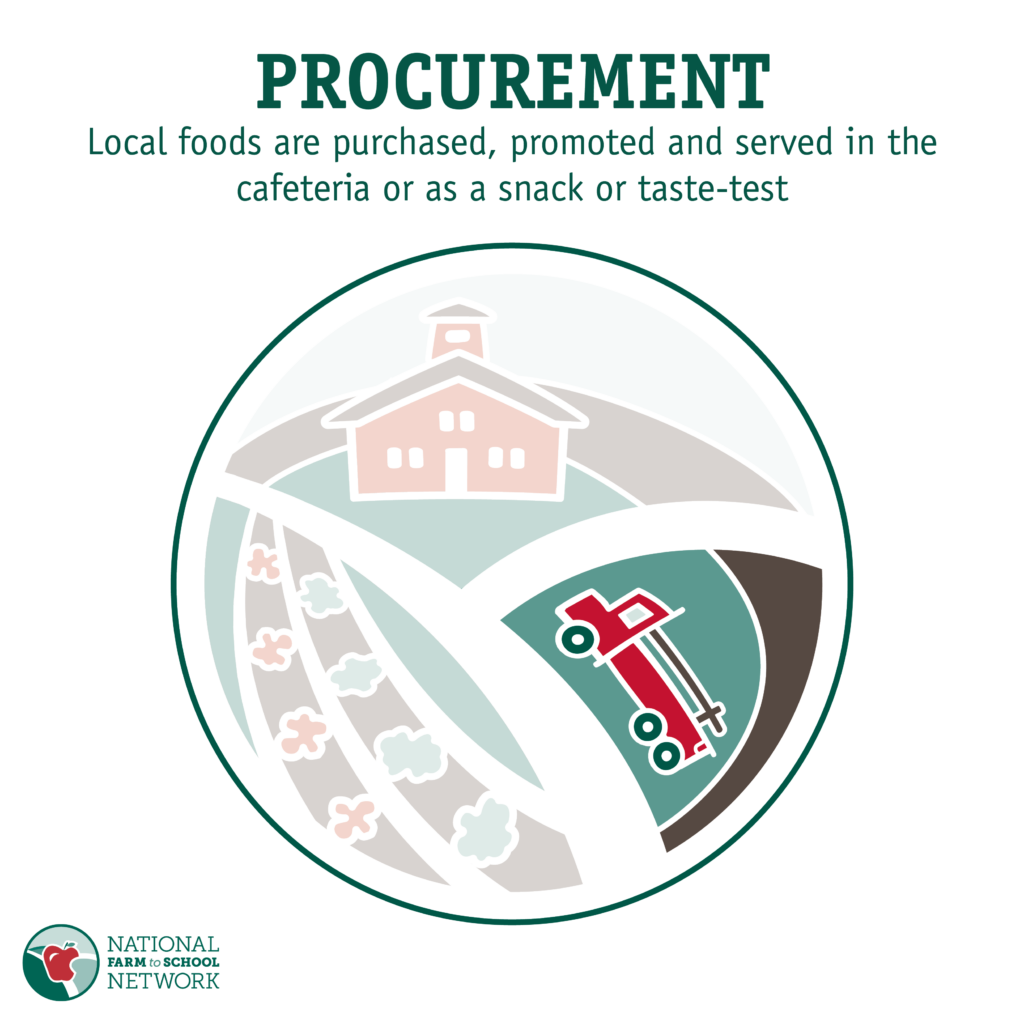

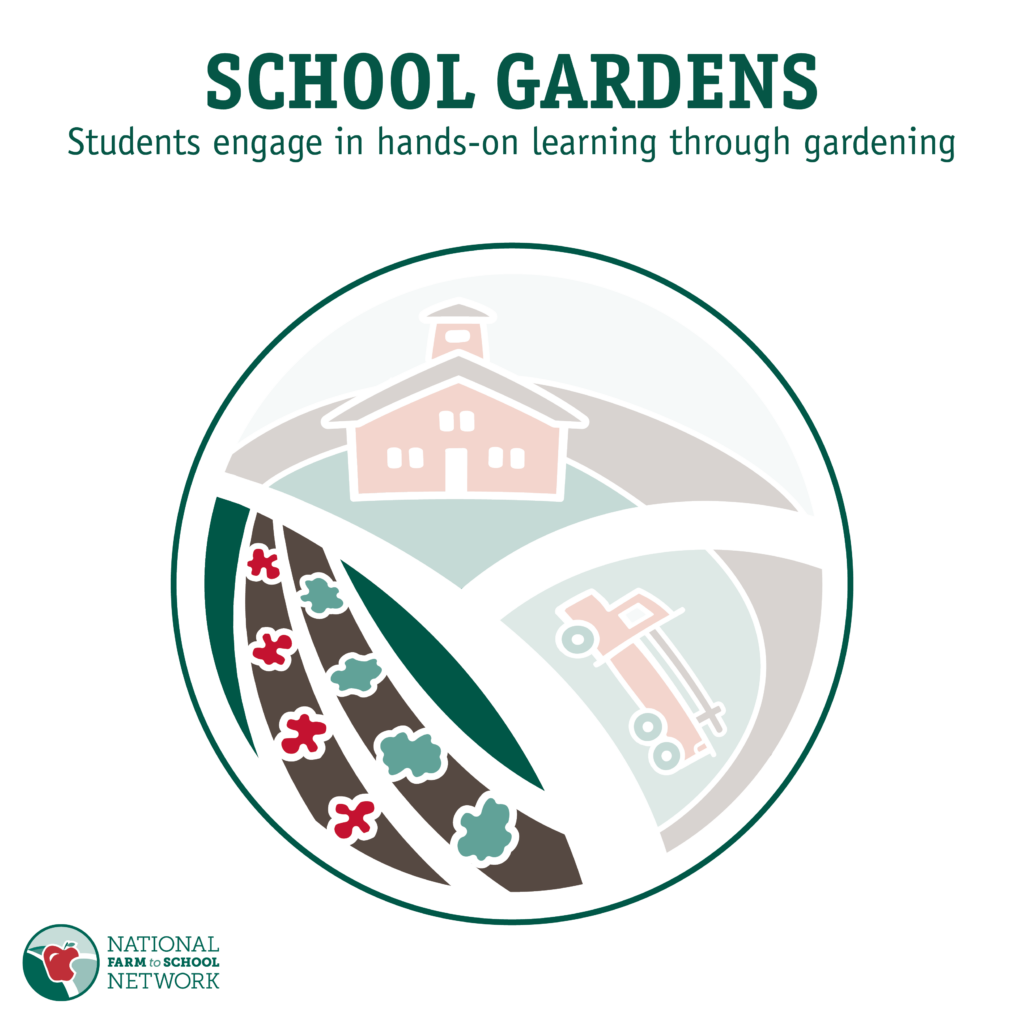
Our USDA Food and Nutrition Services administers the Farm to School Program to promote and support the use of local foods in Child Nutrition Programs. They administer a periodic Farm to School Census to assess the state of farm to school activities across the U.S. For more info on the Farm to School Census and the results – visit this website.
Why Farm to School?
Farm to school has proven to be a powerful tool for individual and community benefit. Studies show that farm to school has led to healthy kids and healthy communities. Supporting schools with incorporating all three elements of farm to school leads to a culture change that ripples out into the community, strengthening awareness of local agriculture and the value it brings to each one of us every single day. Through Farm to School, kids start to connect with food, learn about being a part of a resilient food system, are inspired to explore agricultural and food systems careers, and schools learn new ways to reinvest in their community. Benefits include:

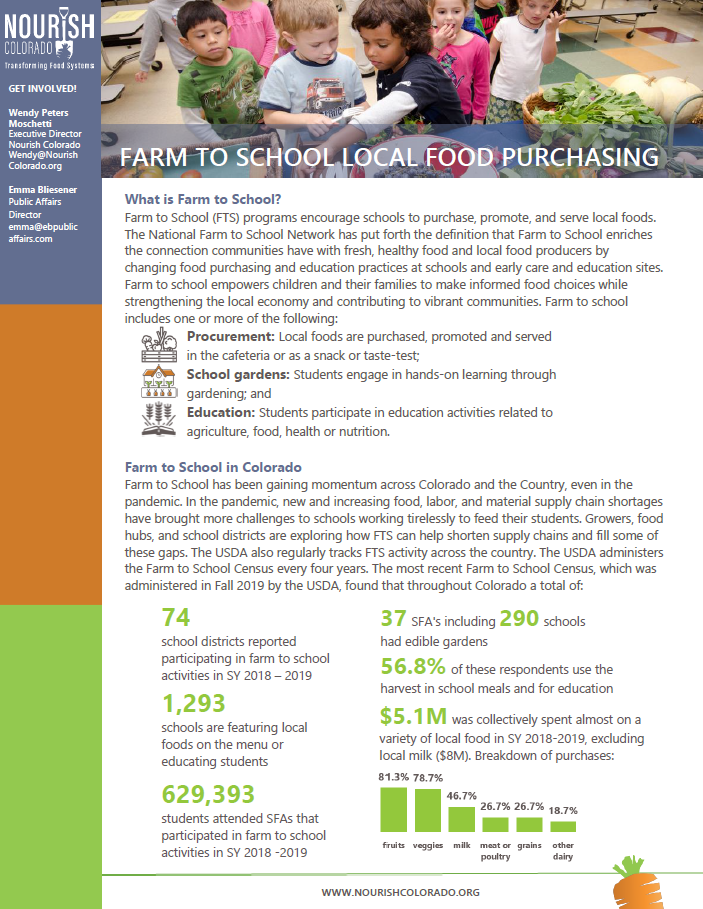
For more details about the benefits of Farm to School with references, check out our Farm to School White Paper. A key benefit is within economic development, as studies have shown that for each dollar invested in farm to school, it stimulates an additional $0.60-$2.16 of local economic activity! Along with this, investing in local products can lead to enhanced meal quality which promotes increased meal participation and consumption of those meals. Nationally, students with Farm to School programs eat 37% more vegetables and 11% more fruit! And the experiential learning opportunities offered through Farm to School programs create widespread benefits for students, teachers, and our communities.
History of Farm to School in Colorado
Farm to School in Colorado isn’t a new concept. Conversations and programs started sprouting up in 2006 by School Meal Operators across the State. They recognized the value of investing in local agriculture and directing a percent of their budgets to purchasing local foods. These trailblazers started small with their purchases and over time, increased the amount they were purchasing.
In 2010, the Colorado Farm to School Task Force is formed through the CO General Assembly and they start leading regional workshops around the state. They created a roadmap for supporting Farm to School and even tried to pass legislation giving schools money to buy local. Now, our Legislators weren’t ready for that, however, the Farm to School efforts didn’t stop there and our Operators kept plugging away. Along with this, The Colorado Health Foundation invested in enhancing the quality of school meals by increasing scratch-cooking and the usage of fresh produce. This was the LiveWell@School Food Initiative which reached over 56% of the School Districts in Colorado during its run from 2010-2018. Since local products tend to be whole and require preparation (such as chopping, dicing, slicing, etc.), the School Food Initiative helped lay a solid foundation for more schools to start taking steps forward with their own Farm to School efforts.
In School Year 18/19 our Department of Education tracked that school districts spent $68k on local food. And one common barrier to entry came down to cost. At this time, a couple other States had passed Legislation giving schools money to buy local. The time was finally feeling right to try and pass legislation again, so we put our heads down and got to work.

- Historical Resources and Reports to reference
The Local Food Program (Pilot Program)
Passed Bills and Local Food Program White Paper
Below is the original Legislation and Fiscal Note for the Local Food Program (Pilot Program). You can also find the Legislation and Fiscal Note for the Healthy School Meals for All Program (HB22-1414).
CDE’s Legislative Reports
These reports cover data on the participating providers, the funds spent, the agricultural producers selling to schools, the training provided, and many other details. One key highlight is that $500,000 spent on local food equates to $864,001.38 in local economic impact!
Local Food Program (Pilot Program) Training and Technical Assistance Needs
The Local Food Program officially launched in School Year 21-22 with our “sweet 16” being selected to participate. In the third and final year of the Pilot Program, we now have 31 Participating Providers! Click here to see where these providers are located and who all participated in the Pilot Program along with details about the Training and Technical Assistance Team.

Here is our Infographic for Year 3 of the Local Food Program – specific to the Returning Providers from Year 2. We had 31 Participating Providers during School Year 23-24. This Infographic looks at the providers who returned from Year 2 and how their responses shifted from Year 2 into Year 3.

Here is our Infographic for Year 3 of the Local Food Program – specific to the New Participating Providers. We had 31 Participating Providers during School Year 23-24. This Infographic looks at the 13 new participating providers and their responses surrounding the process of buying, preparing, and promoting local foods.
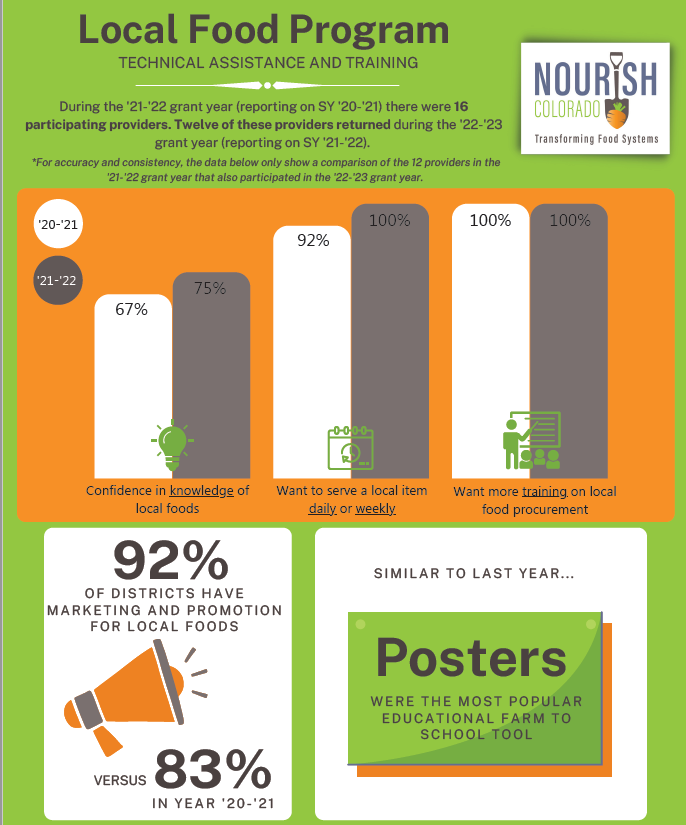
Here is our Infographic for Year 2 of the Local Food Program – specific to the Returning Providers from Year 1. We had 20 Participating Providers during School Year 22-23. This Infographic looks at the providers who returned from Year 1 and how their responses shifted from Year 1 into Year 2.
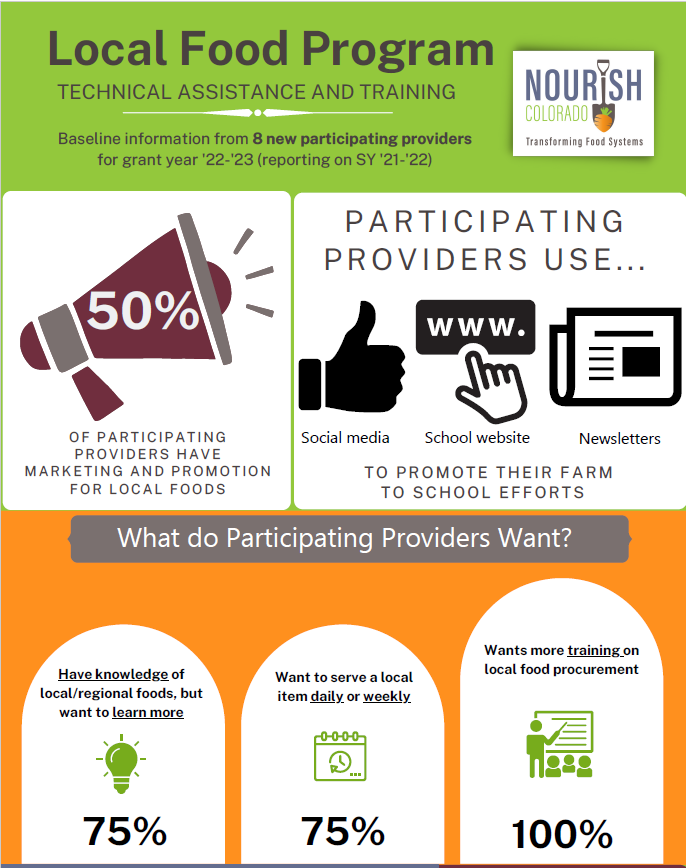
Here is our Infographic for Year 2 of the Local Food Program – specific to the New Participating Providers. We had 20 Participating Providers during School Year 22-23. This Infographic looks at the 8 new participating providers and their responses surrounding the process of buying, preparing, and promoting local foods.
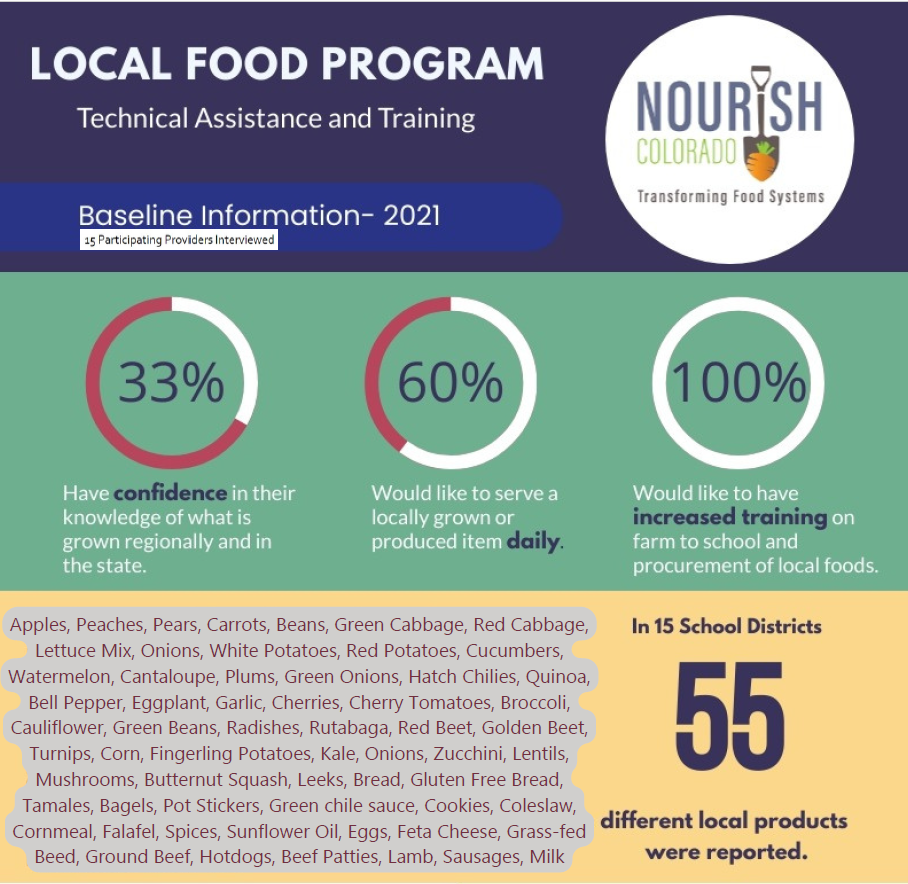
Here is our Infographic for Year 1 of the Local Food Program. We had 16 Participating Providers during School Year 21-22 and this Infographic looks at their responses surrounding the process of buying, preparing, and promoting local foods.
Local Food Program (Pilot Program) Grant Expenditures
These infographics show how the money is being spent by our participating providers. It gives you details as to the market channels (farm, food hub, large distributor, etc.) and types of products being purchased. Agricultural Producers may find this very useful when seeking to understand which local products our schools are most commonly purchasing.
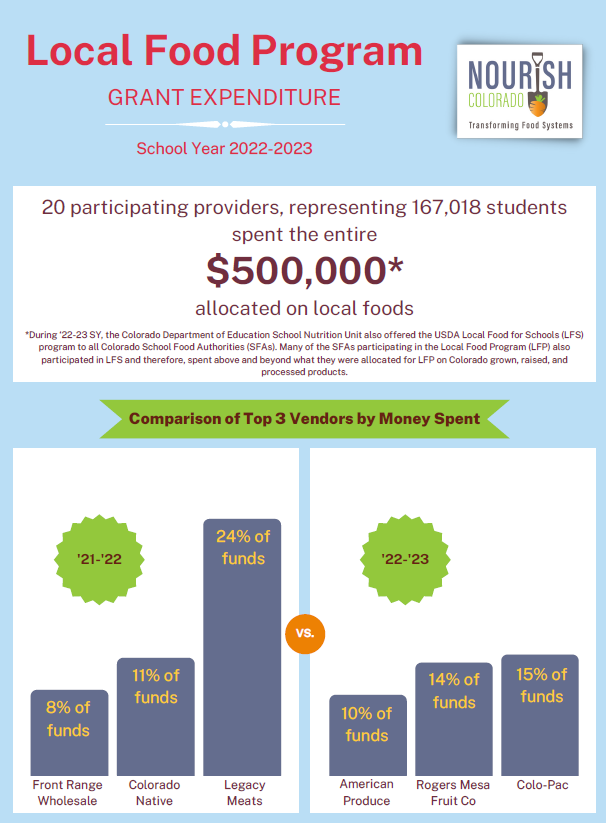
Grant Expenditures for Year 2 of the Local Food Program. In this year, Participating Providers only tracked their local purchases specific to the amount they received from the Pilot Program. During this time, CDE was offering additional funds to buy local through a program called Local Food for Schools (LFS) that was a one-time pot of funds offered through USDA. Most districts in the Pilot Program spent their funds and then tapped into the LFS Funds which had a separate tracking spreadsheet.
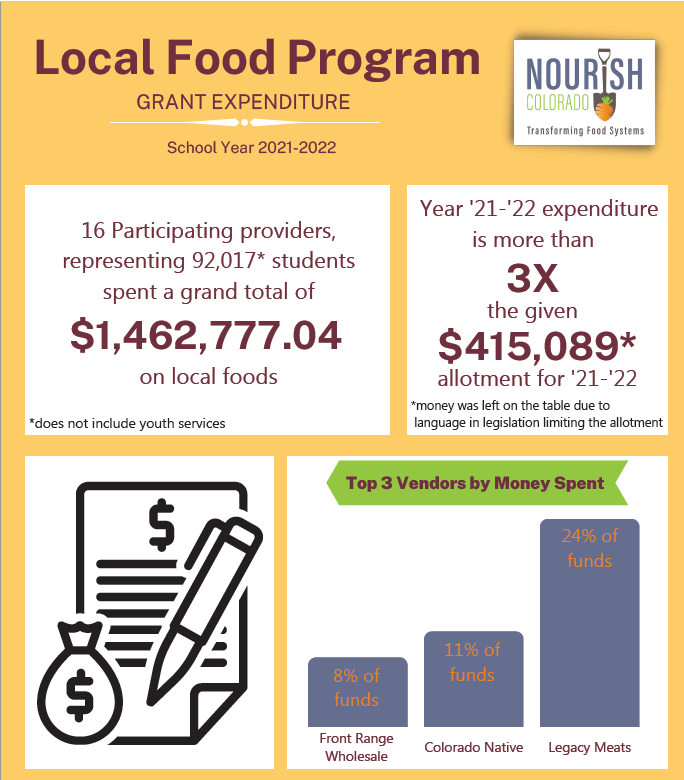
Grant Expenditures for Year 1 of the Local Food Program. In this year, the Participating Providers tracked their local purchases above and beyond the amount they received from the Pilot Program.
The Farm to School Mapping Project
School District Local Food Purchases & Colorado’s Food System Infrastructure. This project was created by Cahill Shpall, a fellow of the Colorado Food Systems Advisory Council. It digs into the Local Food Program with data collected, strategies for collecting that data, and so much more. Highly recommend checking this resource out!
Policy Resources
National Farm to School Network (NFSN) – Policy Research
As Core Partners of the NFSN, we work closely with various members on their team to inform and learn about strategies that’ll move the needle forward on making Farm to School the norm in Colorado.
- State Farm to School Policy Handbook – 2002-2020
- NFSN is currently updating their Policy Handbook and once it is available, we will add it here. Their Policy Handbook played an integral role in the crafting of our Local Food Program Legislation. We spent close to a year digging through it, connecting with other States to learn from them, and reading various types of legislation to inform the bill we moved forward with. We also met with key stakeholders across CO as we designed the bill that was ultimately signed into law in June 2019.
Statewide Farm to School Procurement Incentives
This Google Folder is filled with an incredible amount of research by Cassandra Bull, MS for her thesis. It details the varying Local Food Incentives around the Nation, how they are structured, the amount available, lessons learned, and much more. We recommend diving into the entire Google Folder with a couple specific call outs below.
- Full Report – State Farm to School Procurement Incentives
- Farm to School Incentives – State Program Compendium
- This report has sections for each individual State that has a Local Purchasing Incentive. While it is full of details, we find it very easy to read and incredibly informative.
- State Local Food Procurement Incentives Evaluations or Reports
- If you are curious to see the varying reports each State has put together for their programs, you can find them here.
- State Tracking Sheets
- One of our personal favorites to look through – this gives you insight into how States are asking their participating schools to track their local purchases.


